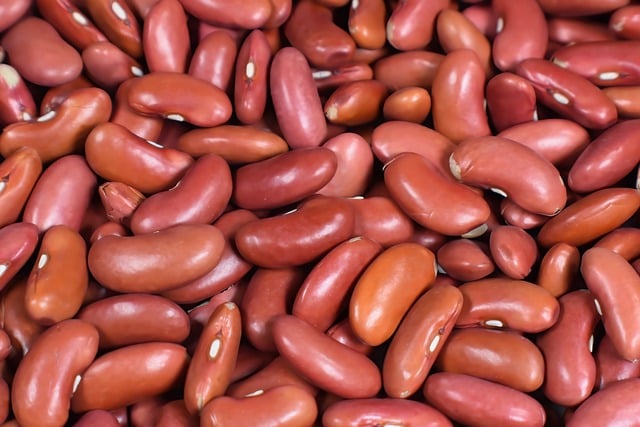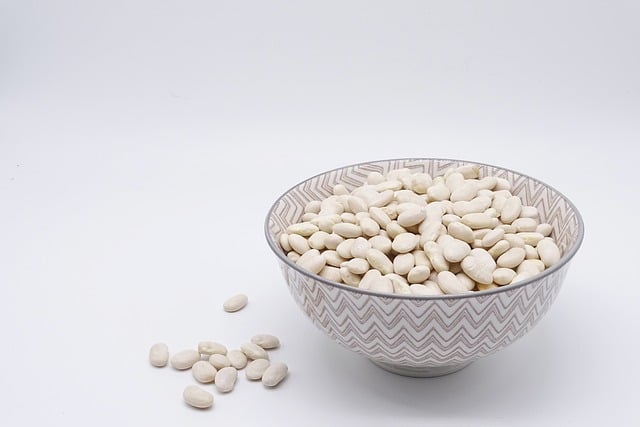Kidney beans are a nutrient-dense legume that offer significant health benefits, particularly for those on a plant-based diet. They're an excellent source of protein and fiber, which contribute to muscle repair, digestive health, heart health by lowering cholesterol, and stable blood sugar levels. These beans also provide iron, potassium, and B vitamins, supporting overall well-being and energy levels. To maximize these benefits, it's important to select fresh, firm kidney beans and store them properly—canned beans should remain sealed until use, while dried beans should be kept in an airtight container in a cool, dark place or the refrigerator. Proper preparation is key for nutritional optimization and improved digestibility; soaking kidney beans overnight is recommended to reduce antinutrients and enhance flavor and nutrient absorption. Cooking methods include both traditional soak-and-boil and quick-soak options, with seasoning added toward the end to create delicious dishes that can be incorporated into a variety of recipes. By understanding how to cook kidney beans and incorporating them into your meals, you can enjoy their health perks, including improved heart health, cholesterol management, and better blood sugar control, while adding a satisfying and flavorful component to your plant-based diet.
Embark on a culinary journey with our comprehensive guide to cooking kidney beans, a versatile and nutritious ingredient that’s a staple in many kitchens around the world. This article demystifies the process of preparing these health-promoting legumes, ensuring you reap their cholesterol-lowering and blood sugar control benefits while integrating them into your plant-based diet. From the initial selection and storage to mastering the gentle soaking method and achieving a creamy texture with perfect flavor, we’ve got all the steps covered. Plus, discover how to creatively incorporate kidney beans into your meals and enjoy a variety of recipes for every time of day. Learn the science behind digestion-friendly preparation to make these beans a delightful addition to your table. Whether you’re a novice cook or looking to expand your repertoire, this guide will equip you with the knowledge to unlock kidney beans’ full potential.
- Unlocking the Nutritional Powerhouse: Health Benefits of Kidney Beans
- A Comprehensive Guide to Selecting and Storing Kidney Beans for Optimal Freshness
- The Gentle Soaking Method: Preparing Kidney Beans for Cooking
- Kidney Bean Cooking 101: Simple Steps for Creamy Texture and Perfect Flavor
Unlocking the Nutritional Powerhouse: Health Benefits of Kidney Beans

Incorporating kidney beans into your diet unlocks a trove of health benefits, making them a valuable component for those following a plant-based diet. These legumes are replete with nutrients that contribute positively to one’s health. For instance, kidney beans are an excellent source of protein, which is crucial for muscle repair and growth, and they provide a significant amount of fiber, aiding in digestive health and satiety. Moreover, their high content of complex carbohydrates allows for gradual blood sugar control, a benefit that can be particularly advantageous for individuals managing diabetes or insulin resistance. From a nutritional standpoint, kidney beans are also renowned for their ability to help reduce cholesterol levels thanks to their soluble fiber content. This fiber binds with cholesterol in the digestive system and helps remove it from the body, thereby supporting heart health. Additionally, they are a rich source of vital micronutrients such as iron, potassium, and B vitamins, contributing to overall well-being and energy levels. When learning how to cook kidney beans, one can choose from a variety of preparation methods—whether you prefer them simmered in a hearty chili or mashed into a flavorful side dish—there are numerous ways to enjoy these health-promoting legumes as part of a balanced and nutritious diet.
A Comprehensive Guide to Selecting and Storing Kidney Beans for Optimal Freshness

When incorporating kidney beans into your diet, it’s crucial to select and store them properly to maintain their health benefits and ensure they are safe to consume. Kidney beans are a staple in many plant-based diets due to their high protein content, which contributes to muscle building and repair while also being cholesterol-free, making them an excellent choice for heart health. To optimize these benefits, begin by selecting the freshest beans possible. When shopping, opt for beans that are firm, well-shaped, and free from blemishes or signs of spoilage. Avoid any cans with bulging lids or packages with visible moisture, as these may indicate contamination with bacteria such as Clostridium botulinum, which can cause a serious form of food poisoning.
Once you have the right beans, storing them correctly is essential for maintaining their freshness and nutritional value. If your kidney beans are dried, store them in an airtight container in a cool, dark place or in the refrigerator if you live in a particularly warm climate. Properly stored dry beans can last for several years. For canned kidney beans, keep them in their original, sealed cans if they will be consumed within a few days. If you plan to keep them longer than that, transfer them to airtight containers and store them in the refrigerator. Always check the expiration date on canned goods before purchase to ensure optimal freshness. By adhering to these storage guidelines, you’ll be able to enjoy kidney beans that are both nutritious and flavorful, contributing positively to blood sugar control by providing a low-glycemic, high-fiber addition to your meals, which can help regulate blood sugar levels when consumed as part of a balanced diet.
The Gentle Soaking Method: Preparing Kidney Beans for Cooking

When incorporating kidney beans into your diet, whether for their health benefits or as part of a plant-based regimen, proper preparation is key to unlocking their full nutritional potential. The gentlest soaking method is an excellent way to prepare kidney beans for cooking, ensuring they are both safe to consume and tender to the bite. This method not only makes the beans more digestible but also helps in reducing antinutrients like phytates that can interfere with the absorption of minerals and contribute to blood sugar control by preventing spikes. Prior to cooking, submerge the dried kidney beans in a large bowl of water, allowing them to soak for at least 6 hours or ideally overnight. This process allows the beans to absorb water and plump up, which also begins to break down some of the complex sugars within the beans, making them easier on the digestion and more compatible with a cholesterol-conscious diet. After soaking, drain and rinse the beans thoroughly. This step removes any excess gas-producing sugars and further reduces antinutrients, enhancing both flavor and nutritional value.
The health benefits of kidney beans are manifold; they’re a great source of protein for those on a plant-based diet, providing a rich and filling alternative to meat while being low in fat and free of cholesterol. Their high fiber content aids in blood sugar control by slowing down digestion and preventing rapid spikes in blood glucose levels, making them an excellent choice for individuals with diabetes or those looking to maintain stable blood sugar. Additionally, the slow release of energy from kidney beans can support sustained physical performance, which is particularly beneficial for athletes or active individuals. By adopting the gentle soaking method as part of your cooking routine, you’re not only ensuring a more pleasant dining experience but also maximizing the health-promoting properties of these versatile legumes.
Kidney Bean Cooking 101: Simple Steps for Creamy Texture and Perfect Flavor

Embarking on a culinary journey to master the art of cooking kidney beans can be both nutritious and satisfying. These versatile legumes are not only a staple in many cuisines but also offer significant health benefits. Rich in protein and fiber, kidney beans are an excellent choice for those following a plant-based diet. They’re low in fat and devoid of cholesterol, making them a heart-healthy option that can aid in blood sugar control due to their low glycemic index. To achieve a creamy texture and perfect flavor when cooking kidney beans, start by sorting through your dried beans to remove any shriveled or damaged ones, which could spoil the dish. Rinse them under cold water to rid them of any dust or impurities.
There are several methods to cook kidney beans, each lending a unique twist to their final taste and tenderness. The soak-and-boil method is a classic approach that not only softens the beans but also enhances their digestibility. To soak, place the beans in a large bowl and cover them with plenty of cold water; let them sit for 8 to 10 hours or overnight. After soaking, drain the water and transfer the beans to a pot. Cover them with fresh water and bring to a boil. Reduce the heat to a simmer, and let them cook until tender, which can take anywhere from 1 to 3 hours depending on the type of kidney bean. Throughout the cooking process, skim off any foam or impurities that rise to the surface to ensure a clean flavor profile. For those in a hurry, a quick-soak method is available: Bring the beans and water to a boil for 2-3 minutes, then let them sit, covered, for an hour before cooking. Seasoning can be added toward the end of cooking to infuse the beans with aromatics like garlic, onion, or bay leaves, which will complement their natural earthiness with a depth of flavor that pairs well with a myriad of dishes, from salads to stews. Whether you’re looking to enhance heart health, manage cholesterol levels, or simply enjoy the satisfying texture and taste of kidney beans, mastering this simple cooking process is a step towards culinary success and nutritional well-being.
Embarking on a culinary journey with kidney beans not only promises a satisfying meal but also aligns with health-conscious eating patterns. This guide has unlocked the nutritional powerhouse within these legumes, highlighting their significant health benefits, including support for cholesterol management and blood sugar control, making them an excellent addition to a plant-based diet. By mastering the gentle soaking method and understanding how to cook kidney beans for a creamy texture with perfect flavor, you’re now equipped to elevate your dishes and enhance your nutrition profile. Embrace these insights to make the most of kidney beans in your kitchen endeavors, fostering both well-being and culinary delight.



